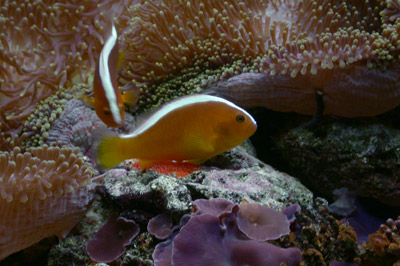crpeck
Premium Member
That sounds okay.
But if you're going to try and capture this batch this week, you should probably buy more rotifers than just the starter pack. You'll want one pack to put in one of your 5 gallon buckets to culture and one to put in the rearing tank.
In your rotifer culture, just add enough food to keep the water green. You can culture in your rearing tank too a bit ... just don't keep the water quite as green and watch your ammonia. If you add a little rotifer food to the rearing tank, you can at least keep some of the rotifers alive and reproducing there that don't get eaten.
In Wilkerson's book, she tells you how to draw a circle on a hydrometer to measure your rotifer density in the water. You'll want to keep an eye on the density in both tanks. In the rearing tank, it needs to be high enough that the larvae literally run into them without looking. In the culture tank, you need to cull if it is getting too dense, but what you're taking out to replenish the rearing tank should be more than enough with a new culture.
Actually ..... you will probably be a bit tight on rotifers if you go for it this week if you get a lot of larvae out.
Oh ... one other warning. On one batch, I accidentally had the airstone running a little too hard and lost a bunch of larvae over the first night. The airflow should be just enough for the bubbles to break the surface of the water, but not hard enough to create a strong enough flow in the tank to blow the larvae around. You can crank up the air as they gain strength.
Good Luck! Keep us posted.
But if you're going to try and capture this batch this week, you should probably buy more rotifers than just the starter pack. You'll want one pack to put in one of your 5 gallon buckets to culture and one to put in the rearing tank.
In your rotifer culture, just add enough food to keep the water green. You can culture in your rearing tank too a bit ... just don't keep the water quite as green and watch your ammonia. If you add a little rotifer food to the rearing tank, you can at least keep some of the rotifers alive and reproducing there that don't get eaten.
In Wilkerson's book, she tells you how to draw a circle on a hydrometer to measure your rotifer density in the water. You'll want to keep an eye on the density in both tanks. In the rearing tank, it needs to be high enough that the larvae literally run into them without looking. In the culture tank, you need to cull if it is getting too dense, but what you're taking out to replenish the rearing tank should be more than enough with a new culture.
Actually ..... you will probably be a bit tight on rotifers if you go for it this week if you get a lot of larvae out.
Oh ... one other warning. On one batch, I accidentally had the airstone running a little too hard and lost a bunch of larvae over the first night. The airflow should be just enough for the bubbles to break the surface of the water, but not hard enough to create a strong enough flow in the tank to blow the larvae around. You can crank up the air as they gain strength.
Good Luck! Keep us posted.








